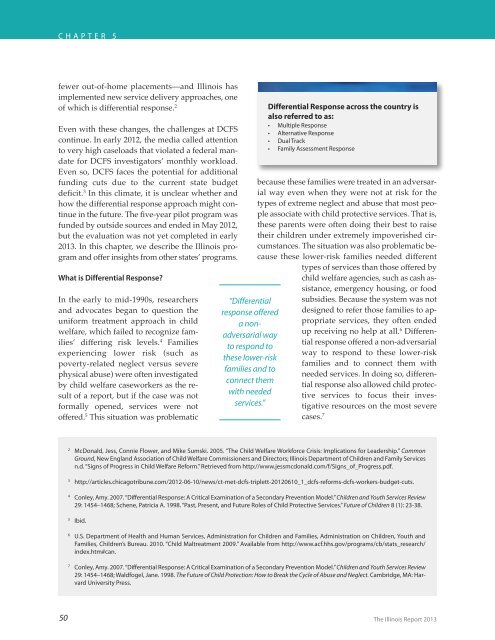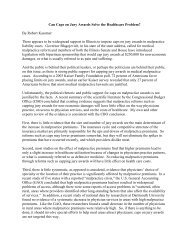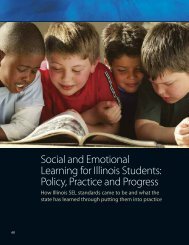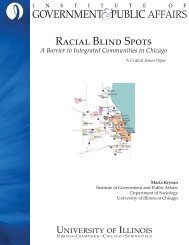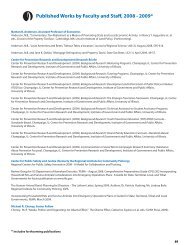The Illinois Report 2013 - Institute of Government & Public Affairs ...
The Illinois Report 2013 - Institute of Government & Public Affairs ...
The Illinois Report 2013 - Institute of Government & Public Affairs ...
Create successful ePaper yourself
Turn your PDF publications into a flip-book with our unique Google optimized e-Paper software.
C H A P T E R 5<br />
fewer out-<strong>of</strong>-home placements—and <strong>Illinois</strong> has<br />
implemented new service delivery approaches, one<br />
<strong>of</strong> which is differential response. 2<br />
Even with these changes, the challenges at DCFS<br />
continue. In early 2012, the media called attention<br />
to very high caseloads that violated a federal mandate<br />
for DCFS investigators’ monthly workload.<br />
Even so, DCFS faces the potential for additional<br />
funding cuts due to the current state budget<br />
deficit. 3 In this climate, it is unclear whether and<br />
how the differential response approach might continue<br />
in the future. <strong>The</strong> five-year pilot program was<br />
funded by outside sources and ended in May 2012,<br />
but the evaluation was not yet completed in early<br />
<strong>2013</strong>. In this chapter, we describe the <strong>Illinois</strong> program<br />
and <strong>of</strong>fer insights from other states’ programs.<br />
What is Differential Response?<br />
In the early to mid-1990s, researchers<br />
and advocates began to question the<br />
uniform treatment approach in child<br />
welfare, which failed to recognize families’<br />
differing risk levels. 4 Families<br />
experiencing lower risk (such as<br />
poverty-related neglect versus severe<br />
physical abuse) were <strong>of</strong>ten investigated<br />
by child welfare caseworkers as the result<br />
<strong>of</strong> a report, but if the case was not<br />
formally opened, services were not<br />
<strong>of</strong>fered. 5 This situation was problematic<br />
“Differential<br />
response <strong>of</strong>fered<br />
a nonadversarial<br />
way<br />
to respond to<br />
these lower-risk<br />
families and to<br />
connect them<br />
with needed<br />
services.”<br />
Differential Response across the country is<br />
also referred to as:<br />
• Multiple Response<br />
• Alternative Response<br />
• Dual Track<br />
• Family Assessment Response<br />
because these families were treated in an adversarial<br />
way even when they were not at risk for the<br />
types <strong>of</strong> extreme neglect and abuse that most people<br />
associate with child protective services. That is,<br />
these parents were <strong>of</strong>ten doing their best to raise<br />
their children under extremely impoverished circumstances.<br />
<strong>The</strong> situation was also problematic because<br />
these lower-risk families needed different<br />
types <strong>of</strong> services than those <strong>of</strong>fered by<br />
child welfare agencies, such as cash assistance,<br />
emergency housing, or food<br />
subsidies. Because the system was not<br />
designed to refer those families to appropriate<br />
services, they <strong>of</strong>ten ended<br />
up receiving no help at all. 6 Differential<br />
response <strong>of</strong>fered a non-adversarial<br />
way to respond to these lower-risk<br />
families and to connect them with<br />
needed services. In doing so, differential<br />
response also allowed child protective<br />
services to focus their inves -<br />
tigative resources on the most severe<br />
cases. 7<br />
2<br />
McDonald, Jess, Connie Flower, and Mike Sumski. 2005. “<strong>The</strong> Child Welfare Workforce Crisis: Implications for Leadership.” Common<br />
Ground, New England Association <strong>of</strong> Child Welfare Commissioners and Directors; <strong>Illinois</strong> Department <strong>of</strong> Children and Family Services<br />
n.d. “Signs <strong>of</strong> Progress in Child Welfare Reform.” Retrieved from http://www.jessmcdonald.com/f/Signs_<strong>of</strong>_Progress.pdf.<br />
3<br />
http://articles.chicagotribune.com/2012-06-10/news/ct-met-dcfs-triplett-20120610_1_dcfs-reforms-dcfs-workers-budget-cuts.<br />
4<br />
Conley, Amy. 2007. “Differential Response: A Critical Examination <strong>of</strong> a Secondary Prevention Model.” Children and Youth Services Review<br />
29: 1454–1468; Schene, Patricia A. 1998. “Past, Present, and Future Roles <strong>of</strong> Child Protective Services.” Future <strong>of</strong> Children 8 (1): 23-38.<br />
5<br />
Ibid.<br />
6<br />
U.S. Department <strong>of</strong> Health and Human Services, Administration for Children and Families, Administra tion on Children, Youth and<br />
Families, Children’s Bureau. 2010. “Child Maltreatment 2009.” Available from http://www.acf.hhs.gov/programs/cb/stats_research/<br />
index.htm#can.<br />
7<br />
Conley, Amy. 2007. “Differential Response: A Critical Examination <strong>of</strong> a Secondary Prevention Model.” Children and Youth Services Review<br />
29: 1454–1468; Waldfogel, Jane. 1998. <strong>The</strong> Future <strong>of</strong> Child Protection: How to Break the Cycle <strong>of</strong> Abuse and Neglect. Cambridge, MA: Harvard<br />
University Press.<br />
50<br />
<strong>The</strong> <strong>Illinois</strong> <strong>Report</strong> <strong>2013</strong>


